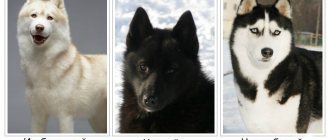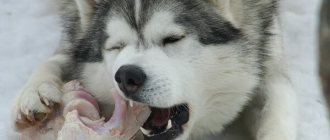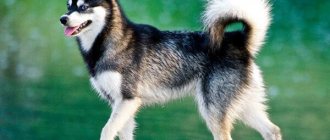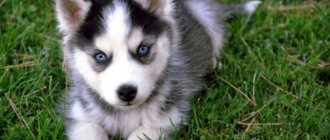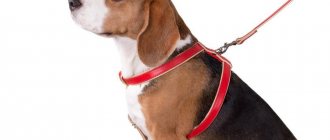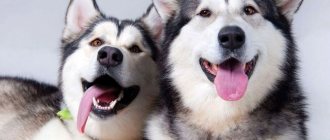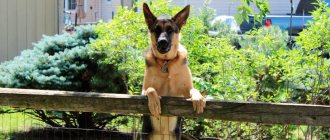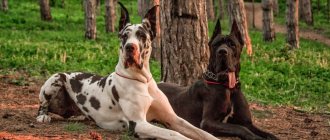Beauty, loyalty, reliability - these are the characteristics of amazing dogs directly created by nature and man. Large and intelligent almond-shaped eyes of a heavenly color, outlined with a black or white stripe. They have a thick and soft undercoat and medium pile. A beautiful large fluffy tail upturned and erect ears, as well as powerful paws.
She cannot show aggression against her faithful companion. Never showing aggression towards either her companion or other strangers. This is a beauty, once born from a mixture of the blood of wolves and northern domesticated dogs - the standard of devotion to the owner.
Purpose
Huskies can be used as a sled dog and as a companion . Many fanciers get several dogs of this breed at once in order to form a full-fledged team for participation in competitions.
But even one husky dog can keep you company on a hike in the mountains or on a winter ski trip. Thanks to her goodwill and charm, the ability to make independent decisions in a difficult situation and high intelligence, the husky has become an excellent pet.
Does it apply to riders?
The large snow-covered expanses of Siberia, where frosts are off the charts, and sparsely populated areas have created a need for such a dog. A strong, devoted and reliable assistant who will help, understand, support and save in the incredibly difficult living conditions of humans in the northern regions. The Chukchi were able to domesticate this animal to the Husky , hence the name of the Eskie breed from the American Husky.
This and only this was its main purpose. Transport cargo over vast distances, despite the cold and raging snowstorms.
The Americans appreciated this breed of sled dogs, took them to Alaska and placed them on a podium and turned them into a national treasure of America. And she deserves it, and so that they don’t forget where she came from, they called her Siberian.
During the “gold rush” in the 30s, this dog, so similar to a wolf and so friendly to humans, could not help but arouse admiration , as it steadfastly endured, together with humans, all the hardships and hardships of camp life in the harsh climate of the Far North.
Eskimo sled dogs have long been bred to help people who fished and hunted. Usually, for a good team, at least 9 dogs were used, and they were fed dried fish. Dogs were never divided into the categories of sled dogs, hunting dogs, or reindeer dogs and were used as universal dogs.
Hunting breed or not?
The feeding of northern aboriginal dogs still retains its unusual nature . The animals feed by hunting; as soon as the snow melts, the team is released into the wild. Thanks to this, all such dogs have a highly developed hunting instinct, but whether they are suitable for hunting is a somewhat controversial issue. And although it is, of course, possible to interest them, and the dogs hunt, they will not bring prey to the owner.
Their diet includes field mice, small birds, and sometimes a Husky can catch up with a hare and tear it to pieces. And if Huskies unite in a pack, they can drag away a goat.
Such hunting instincts often lead to dogs, as predators, attacking cats and killing them, although if they grew up with cats in the house, they do not touch them. This feature of Husky behavior often leads to conflicts with neighbors.
Is it suitable as a security guard for a private home?
Watchdog and security qualities are completely absent from these dogs . Too friendly, showing incredible sympathy, without obvious aggression towards strangers. And a Husky will not be a watchman, since they do not have the instinct to protect their territory. For protection, it is better to choose another breed.
Can he be a defender?
An ordinary Siberian Husky cannot be a protector of the home and owner, unless it is a breed bred in Japan (Akita Inu).
Breeding for sport
Siberian Huskies have had high driving qualities for many years , but time does not stand still. And to breed dogs with higher racing speeds, mixed breeds appeared. There was a mixing of various breeds of hounds and pointing breeds with purebred Huskies.
The resulting dog breeds led to the fact that, while maintaining the advantages of this dog breed, they showed much greater speed as sled dogs in sports. Purebred Huskies still participate in sports races, but they lose greatly to mixed breeds - Alaskan Huskies. The Alaskan Husky is an athletic, very fast and resilient dog.
History of the breed
The history of the origin of any breed largely determines the character of the dogs. There are, for example, breeds bred to protect prisoners or, conversely, property from people. When buying such a puppy, you don’t need to be surprised later that, having matured, the dog bit its neighbor. Likewise, you shouldn’t expect a husky to guard your apartment or dacha. The history of the origin of the Siberian Husky breed goes back centuries and is associated with human exploration of the north. In these harsh conditions, people needed help in hunting, but even more in moving long distances across snowy plains, frozen rivers and the shores of the northern seas. Hence, the husky has amazing endurance - this dog can run for tens of kilometers, keeping you company on long bike rides. Strength – even one adult dog can give not only a child, but also an adult a ride on a sled or cheesecake. The hunting instinct - mice and hamsters, rabbits and hares, chickens and other domestic animals are just food for the husky and convincing your pet that it cannot be eaten will be very difficult.
Huskies are very similar to wolves and often have a rather menacing appearance due to the mask on their face, this can even cause fear in passersby during a walk. This is one of the main curiosities of the breed. The fact is that the Siberian Husky is one of the most human-friendly breeds. Breed historians attribute this to two reasons. The Chukchi and Eskimos crossed the ancestors of huskies with wolves, apparently in order to increase the endurance of the dogs and obtain some other important qualities. However, wolf genes also had a side effect - some of the puppies showed aggressiveness, which the northern peoples fought mercilessly. The second reason is associated with the fact that in the harsh northern conditions, dogs often had to be taken into a house where there were not only adults, but also children. Therefore, there could be no talk of even the slightest signs of aggression towards a person or a child.
Perhaps this is why the husky has an unusually high intelligence. Such close contact with a person could cause the “Mowgli effect” on the contrary, when the need to understand gestures, facial expressions and a rich vocabulary of a person contributed to the development of the dog’s intelligence. Or maybe this is another consequence of wolf genetics - stupid predators do not survive in the wild. One way or another, huskies easily open simple locks in the form of hooks and latches when kept in an enclosure, they can open a bag of food or open a refrigerator. But they easily understand people and quickly learn the commands and habits of their owner. True, this does not at all guarantee that the Husky will obey all these commands without question. This is another one of the breed’s curiosities – the husky’s high intelligence is combined with independence in decision-making. Some historians of the breed attribute this to the fact that when running in a harness, the dogs could feel a crack in the ice and suddenly change route. Therefore, they had the right to make independent decisions. This trait is especially characteristic of male Siberian huskies; they were most often the leaders of the team. The following formula is even common among breeders: “A Husky is a dog with which you need to negotiate.” But you shouldn’t indulge your pet too much. In the north, huskies were kept in packs of 7-9 dogs, as a result they have very developed pack instincts. This means that when raising a dog, you must always clearly indicate who is boss in the house, then the husky will perceive you as the leader of the pack, who must be obeyed.
Despite the name “Siberian Husky”, the country of origin of the breed is considered to be the United States of America. This latest curiosity with the breed occurred at the beginning of the last century. Before the revolution in our country, the number of dogs of northern sled breeds was growing steadily; the development of Siberia was associated with the development of postal and cargo traffic, where it was impossible to do without traditional dog sleds. During the years of Soviet power, with the development of industrial production and the advent of special equipment, the need for sled dogs began to decline. Soviet officials, famous for their formalism, introduced strict regulation of dogs, dividing them into groups based on their benefits to the national economy. Huskies seemed to these rationalizers to be too small for a draft animal and their breeding was prohibited. It is characteristic that at the same time, the Americans, who were distinguished by their entrepreneurial spirit, on the contrary, highly appreciated the driving characteristics and endurance of the breed, began breeding it and in 1930 they were recognized by the American Kennel Club, and in 1932 the first breed standards were developed. Huskies received the prefix “Siberian” so as not to confuse them with the larger dogs of the Alaskan Eskimos. They were also called Huskies by Alaskan gold miners as a result of a corruption of the word "Eskimo" and shortening it to "Eski". In the USA, the breed actively developed and received wide recognition, including due to the case when, thanks to a team of huskies, it was possible to deliver a vaccine against diphtheria to the hard-to-reach city of Nome and save its population from the outbreak of an epidemic. Animated and feature films were made about this feat, and a monument to the Siberian husky Balto was even erected in New York.
Balto
The breed returned to Russia only in the 90s, but quickly found its connoisseurs and professional breeders. By 2000, the Russian Cynological Association had registered more than a hundred puppies of the Siberian Husky breed. Today in Russia there are already several dozen kennels professionally engaged in breeding this interesting breed; dozens of single-breed exhibitions of the national club of northern sled dogs are held annually, in which Siberian huskies are adequately represented. We hope that the professional community will continue to develop, and dogs bred in Russia will be adequately represented at international exhibitions and prestigious competitions.
What else can they do?
The Eskimos always kept their sled dogs outside and only brought them into the house during the birth of a child. They did this in order to warm the child in extreme cold. The pack warmed the child, hence the friendliness of this dog, which would never, under any circumstances, bite a person. Thus, the Eskimos trusted dogs with the most important thing - their offspring.
Breeders do not stand still; they are constantly working on developing certain qualities of dogs, improving their characteristics. There are such varieties of Husky breeds:
- Mini Husky (Klee Kai) is a domestic dog.
- Alaskan Husky.
- The Sakhalin is a rare breed of sled dog.
- Siberian - for exhibitions and racing competitions.
- Japanese (Akita Inu) – guard.
History of the origin of the Husky breed: the beginning
In order to begin an excursion into the origin, it is necessary to first determine the source of the name of the breed. By the way, there are several options:
- The history of the origin of the Husky breed originates in the northern lands. And the word “husky” once meant Eskimos. But I don’t advise you to rush to look for the deep subtext of such a name. It's very simple: "husky" is just a corruption of "eskey". I think many have already guessed that “Eski” and “Eskimo” are one and the same. Only the first option is slightly distorted and has, one might say, slang origin.
- The breed is extremely accurately named also because “husky” in English means “husky.” And this is not a coincidence: the fact is that this breed tends to make growling, hoarse sounds.
So where did the story of this “Growling Eskimo” come from? Around 4,000 years ago, people from what is now Central Asia migrated to the northern regions. And not alone, but with smaller brothers.
We can safely say that the origin of the Husky breed is related to wolves, since active crossing with them took place in the North.
This northern dog lived approximately in the northeastern region of Siberia. For several thousand years, the Chukchi associated their life with this wonderful dog. The fact is that “training” and “husky” are easily compatible concepts, so this breed makes an excellent work companion. The Chukchi were not in the habit of leaving written evidence. However, I think the nuances of their way of life many centuries ago are easy to understand for the reason that they have undergone virtually no changes. By the way, I note that the Husky breed has undergone minimal changes since its origin. Largely due to such conservatism of the people.
How did this breed help? The fact is that a strong, hardy, discreet, intelligent, loyal and active dog could cover many kilometers on an ice-covered surface. And at the same time, I note, there is a minimum need for food! Naturally, hunting grounds did not always provide as much food to humans as required. Therefore, it was in the interests of the Chukchi to periodically move in search of it, and then return to their villages. It is not surprising that this breed of dog came in very handy. Also, in cold weather, huskies willingly shared their warmth with the children of their owners, which, I suspect, significantly helped their survival.
Working individuals in the North
Siberian Huskies are divided conventionally: working, racing, exhibition . “Workhorses” is how these dogs are characterized. Initially they were trained for these purposes. These are smart and unpretentious animals, very hardy and fast.
Huskies carried mail, firewood, meat, and fish, therefore, all those cargoes that helped a person survive in the conditions of the far north. In some villages, dogs that may be direct descendants of modern Huskies are still bred and exploited in Chukotka. Of course, American breeders were more concerned with preserving the exterior of the dogs, which is why they lost their working qualities.
Anyone trying to keep this breed at home must understand the need for physical activity for this dog. He can be a wonderful hiking companion in the summer and even a sleigh ride in the winter.
Animal speed
If we take into account the speed qualities of purebred Huskies, then in 2010 in the race a team of Siberian Huskies came 42 out of 55 in 11 days 20 hours 39 minutes 11 seconds, while the record time for the winner was: 8 days 23 hours 59 minutes 9 seconds.
Siberian Huskies will never win a sprint race, but at middle distances and above they will emerge victorious if they prepare on par with Alaskan Huskies, who are leaders in sports races. They can reach speeds of 15-20 km/h, while Alaskan ones reach speeds of 18-30 km/h.
Despite its friendliness and intelligence, Husky is not as simple as it seems . She has a very willful and independent character. It is difficult to train and it is simply impossible to use the carrot or stick system.
For her, you need to become an authority and a leader so that she starts following commands. And if a person himself is weak-willed, he will not succeed in raising such a dog and will not earn its trust and obedience.
If you don’t train and leave it to chance, the dog will get mad and play pranks. He cannot be punished too much, he is stubborn, it is better to divert his attention and cheer him up with love and affection and persistence. And, of course, physical activity should bring him to the point of fatigue and then he will become pliable. Everything will depend on how they can raise him.
Content Rules
These animals belong to unpretentious breeds. Representatives of this breed are clean, odorless and parasite-free. By their nature they resemble cats. They lick themselves just like cats. In this regard, the husky rarely takes water procedures, twice a year. As for molting, this process occurs twice a year. The molting period is characterized by intense hair loss. As a rule, molting lasts 3-4 weeks. During the rest of the period, molting is not observed. However, it is worth taking into account climatic conditions. Some owners living in constant climatic conditions observe molting throughout the whole year. In everyday life, caring for a Siberian Husky is minimal. The only thing you need to do is periodically comb it out of unnecessary hair. Don't forget about the claws, they need trimming. Nutrition is a necessary and important item in care.
